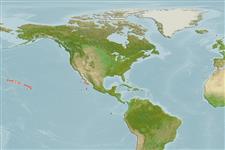Environment: milieu / climate zone / गहराई सीमा / distribution range
पारिस्थितिकी
समुद्री बाथीड़िमरसल; गहराई सीमा 786 - 872 m (Ref. 40826). Deep-water
Eastern Central Pacific: Hawaiian Islands.
आकार / वज़न / Age
परिपक्व अवधि: Lm ? range ? - ? cm
Max length : 13.6 cm SL पुल्लिंग / अलिंग; (Ref. 40826)
पृष्ठीय सौफट रेज़ (सम्पूर्ण) : 6 - 7; जानवरों की रीड़ का जोड़: 18. Unique tubercles multi-spined, clustered in center of each tubercle. No large rostral spine, nor long simple spines on dorsal surface of disc. Tubercles along sides of tail each with 2-4 long, irregularly sized, somewhat flaring spines. Toothed scutes on tubercles absent. (Ref. 40826).
Body shape (shape guide): short and / or deep; Cross section: flattened.
Life cycle and mating behavior
परिपक्व अवधि | पुनरुत्पत्ति | मछलीऔ का अंडे देना | अंडे | Fecundity | लार्वा
Bradbury, M.G., 1999. A review of the fish genus Dibranchus with descriptions of new species and a new genus, Solocisquama (Lophiiformes, Ogcocephalidae). Proc. Calif. Acad. Sci. 51(5):259-310. (Ref. 40826)
IUCN Red List Status (Ref. 130435: Version 2025-1)
Threat to humans
Harmless
Human uses
साधन
Special reports
Download XML
इंटरनेट स्रोत
Estimates based on models
Phylogenetic diversity index (संदर्भ
82804): PD
50 = 0.6250 [Uniqueness, from 0.5 = low to 2.0 = high].
Bayesian length-weight: a=0.02344 (0.00968 - 0.05678), b=2.94 (2.73 - 3.15), in cm total length, based on LWR estimates for this (Sub)family-body shape (Ref.
93245).
Trophic level (संदर्भ
69278): 3.3 ±0.6 se; based on size and trophs of closest relatives
लौटाव (संदर्भ
120179): माध्यम, न्यूनतम जनसंख्या दुगनी होने का समय 1.4 - 4.4 वर्ष। (Preliminary K or Fecundity.).
Fishing Vulnerability (Ref.
59153): Low vulnerability (10 of 100).
🛈
